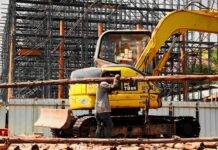
Painting Hazards and Control Measures
Introduction
Painting is a common activity in construction, maintenance, and industrial work. While it may seem relatively low-risk, painting involves various hazards, including chemical exposure, falls, fire risks, and ergonomic strain. This guide outlines key painting hazards and the control measures required to ensure a safe working environment.
Common Painting Hazards and Their Control Measures
1. Exposure to Hazardous Chemicals
Hazard:
- Paints, thinners, and solvents contain volatile organic compounds (VOCs) that can cause respiratory problems, skin irritation, and eye injuries.
- Prolonged exposure to toxic fumes may lead to long-term health effects.
Control Measures:
- Use water-based or low-VOC paints whenever possible.
- Ensure proper ventilation in enclosed areas by using exhaust fans or air movers.
- Provide workers with appropriate personal protective equipment (PPE), including respirators, gloves, and safety goggles.
- Train workers on the safe handling and disposal of hazardous chemicals.
2. Fire and Explosion Hazards
Hazard:
- Oil-based paints, thinners, and solvents are highly flammable and can ignite easily.
- Sparks from electrical tools, smoking, or open flames can cause fires.
Control Measures:
- Store flammable materials in designated, fire-resistant storage cabinets.
- Eliminate ignition sources by prohibiting smoking and using explosion-proof lighting in confined areas.
- Use fire extinguishers and ensure workers are trained in fire response procedures.
- Follow proper ventilation practices to reduce vapor buildup.
3. Falls from Heights
Hazard:
- Painters often work on ladders, scaffolding, or elevated platforms, increasing the risk of falls.
- Slippery surfaces and unstable work platforms can lead to accidents.
Control Measures:
- Use guardrails, safety harnesses, and lanyards when working at heights.
- Ensure ladders and scaffolding are in good condition and properly secured.
- Keep work areas clean and free from tripping hazards.
- Train workers in fall protection measures and safe ladder use.
4. Skin and Eye Irritation
Hazard:
- Direct contact with paint, thinners, or solvents can cause skin burns, rashes, or allergic reactions.
- Paint splashes can lead to eye injuries.
Control Measures:
- Require workers to wear gloves, long-sleeved clothing, and safety goggles.
- Provide eye wash stations and emergency showers in case of accidental exposure.
- Encourage proper hygiene, including washing hands and exposed skin after handling paints.
5. Inhalation of Toxic Fumes and Dust
Hazard:
- Sanding old paint or using spray guns can release toxic dust and fumes, leading to lung diseases.
- Lead-based paints, if disturbed, pose severe health risks.
Control Measures:
- Use dust masks or respirators when sanding or spraying paint.
- Conduct air monitoring to ensure exposure limits are not exceeded.
- Use wet sanding techniques or HEPA-filtered vacuums to reduce airborne dust.
- Implement lead-safe work practices when dealing with old paint.
6. Ergonomic Strains and Musculoskeletal Injuries
Hazard:
- Prolonged standing, overhead painting, and repetitive movements can cause back, neck, and shoulder pain.
- Holding heavy spray equipment for extended periods can lead to muscle fatigue.
Control Measures:
- Rotate tasks among workers to reduce repetitive strain.
- Use ergonomic painting tools such as extension poles and lightweight spray guns.
- Provide regular breaks and encourage stretching exercises.
- Adjust work height and positioning to minimize strain.
7. Electrical Hazards
Hazard:
- Painting near electrical panels, wiring, or using electric spray guns can result in shocks or electrocution.
- Wet conditions increase the risk of electrical hazards.
Control Measures:
- De-energize electrical systems before painting near wiring.
- Use insulated tools and ensure electrical equipment is properly grounded.
- Keep extension cords away from wet surfaces and use GFCI-protected outlets.
- Train workers on electrical safety and hazard recognition.
8. Tripping and Slipping Hazards
Hazard:
- Paint spills, wet surfaces, and misplaced tools create tripping and slipping risks.
- Improperly placed ladders or scaffolding can lead to falls.
Control Measures:
- Keep work areas organized and free from clutter.
- Use drop cloths or non-slip mats to cover slippery surfaces.
- Immediately clean up paint spills and dispose of waste materials properly.
- Mark hazard zones with warning signs and barriers.
9. Confined Space Hazards
Hazard:
- Painting in confined spaces such as tanks, tunnels, or basements increases the risk of suffocation, toxic exposure, and fire.
- Limited ventilation can lead to the accumulation of hazardous fumes.
Control Measures:
- Test air quality before entering confined spaces and ensure proper ventilation.
- Use respiratory protection and continuous air monitoring.
- Follow confined space entry procedures, including permits and standby personnel.
- Have an emergency rescue plan in place.
10. Waste Disposal and Environmental Impact
Hazard:
- Improper disposal of paint waste, solvents, and cleaning agents can contaminate soil and water sources.
- Some paints contain hazardous substances that require special disposal methods.
Control Measures:
- Follow environmental regulations for paint disposal and recycling.
- Use spill containment systems to prevent leaks into drains or waterways.
- Train workers on proper disposal methods and waste management practices.
- Encourage the use of eco-friendly, biodegradable paints.
Conclusion
Painting operations present multiple hazards that require proactive safety measures to prevent accidents and health risks. By implementing proper ventilation, using appropriate PPE, ensuring safe work practices, and adhering to fire prevention protocols, workers can significantly reduce risks associated with painting tasks.
A well-planned and safety-conscious approach to painting not only protects workers but also enhances efficiency and environmental responsibility in construction and maintenance projects.
Common Hazards in Construction Sites and How to Mitigate Them
Batching Plant Hazards and Precautions | Free Download PPT
Monsoon Safety Plan for Construction Site
Safety Engineering in Construction: Managing Risks and Ensuring Compliance

























Yes I am building pantr work and pailng ceiling PVC work building pantr work
Greetings of the day.
It is highly educative on Paints and handling.
The employers has to provide PPE to all the workers, proper training has to be arranged by employer, and yearly periodical medical has to be carried to every employees and keep a record in their medical center.
I am a trainer ,I impart Training to the various levels.
Chandramanipg